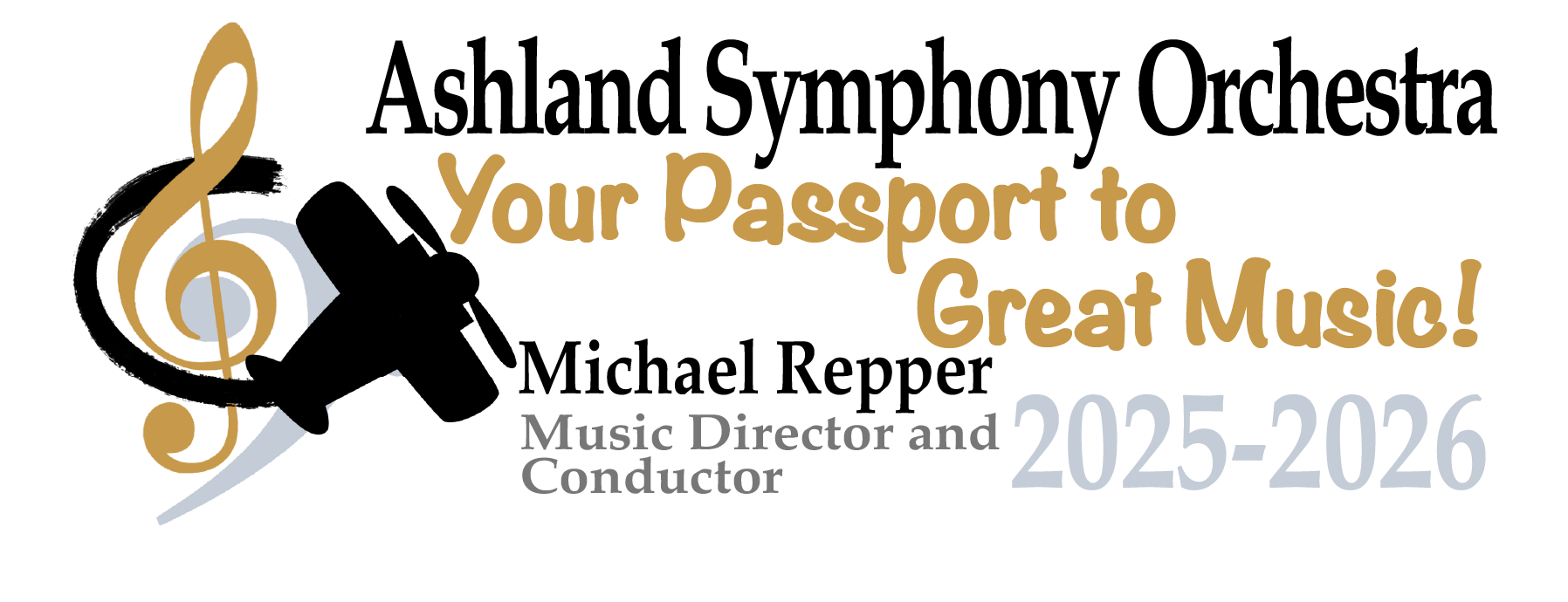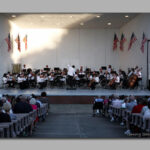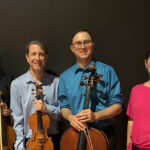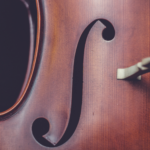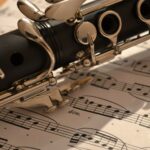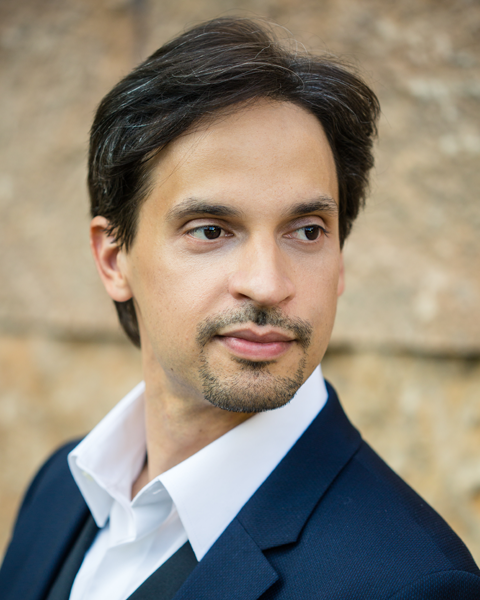Familiar, new-to-us, and grand – all words which can describe this opening concert of the ASO’s 53rd season and Music Director and Conductor Michael Repper’s debut season! Finlandia is bold and a perfect overture for what is to come. Many of Florence Price’s works were lost only to be uncovered in 2009. Composed in 1932, this performance of Ethiopia’s Shadow in America may be just the second time it will be heard in Ohio. The concert concludes with Brahms’ Symphony No.2, the final movement of which has been said, “…the blazing sunrise of the most athletic and ebulliently festive movement Brahms ever wrote”. (Quote – Malcolm MacDonald)
Finlandia – Jean Sibelius
Ethiopia’s Shadow in America – Florence Price
Symphony No.2, op.73, D major – Johannes Brahms
Ethiopia’s Shadow in America by Florence Price is presented under license from G. Schirmer Inc. and Associated Music Publishers, copyright owners.
Dear Friends,
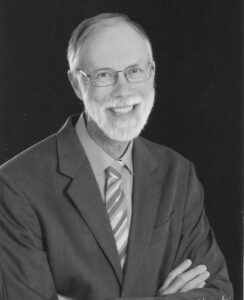
What a thrill it is to welcome you to the 53rd season of concerts with the Ashland Symphony Orchestra. We open a new chapter in ASO history this season as Michael Repper begins his tenure as Music Director and Conductor. With an enthusiastic new Music Director, a cadre of outstanding musicians, and a discriminating and appreciative audience, we are poised to enjoy a great year of music together. ASO will present both familiar and new musical offerings that we expect will delight, challenge, inspire, console, stimulate, or refresh you (or perhaps do a combination of those things).
The ASO Board of Directors thanks you for your continuing support of our outstanding orchestra. We welcome your comments about the ASO and its programs, so please do not hesitate to share your thoughts with any of the Board members. We look forward to finding ways to make each concert even more rewarding for you.
Enjoy the music.
Michael Hupfer
President, ASO Board of Directors
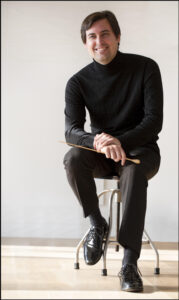 Dear Ashland Symphony Orchestra Patrons,
Dear Ashland Symphony Orchestra Patrons,
It is my great privilege to welcome you to our concerts at the marvelous Robert M. & Janet L. Archer Auditorium. I am incredibly proud to be taking the helm as Ashland’s new Music Director, and to continue to grow this jewel of Ashland County. We are going to make tremendous music together and enjoy a wonderful communal spirit. Our concerts are a place for everyone – come and enjoy, and be sure to introduce yourself! Our musicians and I are incredibly proud to share our work with you, and we hope you enjoy every minute!
Michael Repper
Music Director and Conductor
Ashland Symphony Orchestra
 Here’s to NEW beginnings! For this momentous concert season, we welcome Michael Repper as the ASO’s new Music Director and Conductor, a new Fan Club for students in grades 9-12 and college students, pieces that are new to both patrons and musicians, new collaborations, new fundraisers, the ASO’s new Volunteers Coordinator Mark Gorsuch and new House Manager Ivey Buffenmyer, new complimentary children’s tickets, and much more.
Here’s to NEW beginnings! For this momentous concert season, we welcome Michael Repper as the ASO’s new Music Director and Conductor, a new Fan Club for students in grades 9-12 and college students, pieces that are new to both patrons and musicians, new collaborations, new fundraisers, the ASO’s new Volunteers Coordinator Mark Gorsuch and new House Manager Ivey Buffenmyer, new complimentary children’s tickets, and much more.
We are back together again in the concert hall and I look forward to welcoming returning patrons as well as new audience members.
Come listen to what people are talking about!
Martha Buckner
Executive Director
Ashland Symphony Orchestra
SIBELIUS, Jean: Finlandia, op.26
Born: 8 December 1865, Finland
Died: 20 September 1957, Finland
Composition and Premiere: 1899 in Helsinki, Revised in 1900
Instrumentation: 2 Flutes, 2 Oboes, 2 Clarinets, 2 Bassoons, 4 Horns, 3 Trumpets, 3 Trombones, Tuba, Timpani, Bass Drum, Cymbals, Triangle, and Strings
Duration: 8 Minutes
In 1899, tensions between Russia and Finland reached a new high point, as Russia’s quest for control over the Finnish peninsula grew stronger and stronger. Jean Sibelius, who by the last decade of the 19th century had become recognized as Finland’s preeminent composer, was invited to write a short musical offering to be performed at a political demonstration in Helsinki, to bolster Finnish pride. Thus, the first edition of this piece was born (originally titled Finland Awakes).
The short piece begins with trombones playing tight diminished chords that immediately introduce tension. The prevalence of minor seconds in the first theme (minor seconds are the smallest interval, and one of the most dissonant) build on this tension.
Dissonant and consonant harmonies battle over control of a recurring rhythmic motive in the trombones, until a gallant A-flat major theme shines through, bursting forth like a knight on a horse. Horns feature prevalently, which captures the mood of a battle proudly won.
Eventually the tension and energy yield, and the woodwinds introduce Sibelius’ famous hymn, known throughout the world as the “Finlandia Hymn.” This 32-bar sequence would become so popular with the Finnish people that it became an unofficial national song, and thanks to its popularity worldwide, it has been co-opted by various religions in their hymnbooks. Many Christian denominations might recognize the tune as “Be Still, My Soul.”
Recommended Recording: Oslo Vänskä conducting the Lahti Symphony Orchestra
PRICE, Florence: Ethiopia’s Shadow in America
I. Adagio–Allegretto: The Arrival
II. Andante: His Resignation and Faith
III. Allegro: His Adaptation
Born: 9 April 1887, Little Rock, Arkansas, USA
Died: 3 June 1953, Chicago, Illinois, USA
Composition: 1929-1932 in Chicago
Premiere: Possibly 2015 in Little Rock, Arkansas
Instrumentation: Piccolo, 2 Flutes, 2 Oboes, 2 Clarinets, 2 Bassoons, 4 Horns, 2 Trumpets, 3 Trombones, Tuba, Timpani, Suspended Cymbal, Woodblock, Snare Drum, Bass Drum, Glockenspiel, Xylophone, Crash Cymbals, Celesta, and Strings
Duration: 16 minutes
Ethiopia’s Shadow in America by Florence Price is presented under license from G. Schirmer Inc. and Associated Music Publishers, copyright owners.
Florence Price is one of America’s greatest composers, whose music, due to decades of neglect, is only just now being uncovered in a widespread fashion. Price was interested in music from a very early age, and showed immense talent as well. She gave her first public performances from as young as 4 years old, and began composing around age 10. She was incredibly bright, and graduated with top grades as valedictorian of her high school.
Price eventually decided to pursue higher education in music, and was admitted to the New England Conservatory of Music. She was forced to register as “Mexican” rather than “African American” due to fears that her skin color would prevent the processing of her application or any chance of being admitted.
Price moved to Chicago in the late 1920s, fleeing from the generally unsafe environment for Black people in Little Rock during that period. In Chicago, Florence Price would find tremendous success. Among those successes was the premiere of her first symphony by the Chicago Symphony Orchestra (this was the first time a full-time American orchestra played a work by a Black woman, and the Chicago Symphony was an orchestra with which Price would enjoy a close relationship for years), as well as numerous composition competition wins.
Unfortunately, due to general neglect, Florence Price’s music was largely forgotten between her death and the last decade. Audiences today, however, are falling in love with her music anew, much in the same way they did in the 1930s. Today, we will play one of her most special tone poems, Ethiopia’s Shadow in America.
Price’s musical language is distinctly American, forging together her musical training at the New England Conservatory (where she would have studied Brahms, Beethoven, Bach, and other Western musicians) with her learned American musical customs, and particularly customs stemming from the Black community: jazz, blues, and spirituals, for example. Price’s large pieces, such as her Piano Concerto and also Ethiopia’s Shadow, both contain spirituals in the middle movement — it is easy to see the influence of the Black American musical tradition in her writing.
A tone poem, this piece is programmatic, or music written to portray a specific meaning, image, story, or idea. Ethiopia’s Shadow in America is quite plainly about slavery in this country, and Price’s depiction of a Black person being subjected to slavery. Price’s writing is so organic that it is easy to follow the story as she describes in her own movement titles. Full of drama, this piece is quickly becoming one of Price’s most popular pieces, and a stirring reminder of a dark part of our past.
Recommended Recording: Michael Repper conducting the New York Youth Symphony
BRAHMS, Johannes: Symphony No. 2, op.73, D Major
I. Allegro non troppo
II. Adagio non troppo
III. Allegretto grazioso (Quasi andantino)
IV. Allegro con spirito
Born: 7 May 1833, Germany
Died: 3 April 1897, Austria
Composition and Premiere: 1877, Vienna
Instrumentation: 2 Flutes, 2 Oboes, 2 Clarinets, 2 Bassoons, 4 Horns, 2 Trumpets, 3 Trombones, Tuba, Timpani, and Strings
Duration: 40 minutes
Brahms was an incredibly reluctant symphonic composer for most of his career. Whereas some of his forebears (such as Beethoven and Mendelssohn) were writing and publishing before they were even teenagers, Brahms was into his forties before he published his first symphony.
The reason for this is simple: there was immense expectation amongst the public that Brahms would be the one to carry Beethoven’s legacy forward. Even other preeminent composers thought so, including Robert Schumann who introduced Brahms to a wider audience through his music journal as, essentially, the second coming of Beethoven. That’s a lot of pressure! That, combined with Brahms’ notorious perfectionism meant that Brahms was incredibly slow to symphonic writing, relatively speaking, taking over twenty years to complete his first symphony. Fortunately, his first symphony was such a rousing success that, boosted with confidence, it took him merely months to complete his second symphony, the one we will play today.
Of Brahms’ four symphonies, the second is arguably the sunniest and most radiant. The key to understanding the entire piece comes in the first four notes, as played by the cellos (D – C# – D – A). This short motive of a minor second and a perfect fourth forms the basis for nearly every theme in the piece in some way, and is frequently called back verbatim (such as the opening notes of the fourth movement, also D – C# – D.
Brahms also included fun kernels for his audience, items that may have been meant to be recognizable and enjoyed by Brahms fans. Take, for example, the second theme of the first movement, which highly resembles Brahms’ infamous Lullaby.
Each movement is distinctive. Whereas the first movement is idyllic, the second movement is dramatic. The third movement is playful, and the fourth movement bursts with energy. The fourth movement features trombones in a way that had become quite prominent in Beethoven’s time (trombones playing high notes are a great way to exude energy), and the first trombone is asked to play quite high. A great challenge for any orchestra, and a wonderful way to conclude our concert, we look forward to presenting Brahms’ great Symphony no. 2 for you today.
Recommended Recording: Marin Alsop conducting the London Symphony Orchestra
Violin I
Samuel Rotberg, Concertmaster, James E. Thomas Memorial Endowed Chair
Corrie Anne Riberdy
Stephen Domka
Jacob Campbell
Mary Ann Basinger
Cayleigh Stewart
Jane Reed
Violin II
Mary Kettering, Principal
Cassandra Bryant
Laura McLaughlin
Michael Sieberg
Frances Hamilton
Belita Stout
Pamela Fiocca
Viola
Eva Mondragon, Principal
Joshua Bowman
Jamie Thornburg
Geoffrey Fischer
Isabel Aronin
Sarah Nichols
Cello
Jeffrey Singler, Principal
Melanie Bernhardt
Gillian Derhammer
Bom Kim
Rachel Caserta
Bass
David Lenigan, Principal
Moses Carreker
Aidan Terry
Adam Har-Zvi
Flute
Lisa Jelle, Principal
Carol Oberholtzer, John H. Landrum Memorial Endowed Chair
Denise Rotavera-Krain
Oboe
Andria Hoy, Principal
Axl Pons
Clarinet
Thomas Reed, Principal
Gail Zugger
Bassoon
Ryan Yamashiro, Principal
John Kriewall
Horn
Laura Makara, Principal
Michael Metcalf, Assistant Principal
Timothy Stewart
Benjamin Hottensmith
Jason Riberdy
Trumpet
Kenneth Holzworth, Principal
Ted Clark
Isaac Winland
Trombone
Anthony Weikel, Principal
Mike Montgomery
Devin Roark
Tuba
Charles Kobb, Principal
Timpani
Kiri Georgia, Principal
Percussion
David Wolbert, Principal, Lawrence and Catherine Hiner Endowed Chair
JoAnn McConnell
Torrell Moss
The Ashland Symphony Orchestra thanks
Our ushers and volunteers
Philip McNaull, Technical Director
Ashland City Schools for its continued support of the arts
Tommy Beech, Photographer
Roger Price, Professional Voice Actor & Announcer, www.RogerzVoice.com
Please silence all electronic devices.
No flash photography or audio/visual recording permitted.
No food or drink permitted in the Robert M. & Janet L. Archer Auditorium.
Thank you for your cooperation.
The individuals and associations listed on this page, by their support of the orchestra’s operating fund, make possible the continuance of the Ashland Symphony Orchestra. Additional support is needed and will be most welcome at any time throughout the year. If there is an error, please notify the office. Donations listed as of 8/25/22.
Make Your Giving Memorable
Celebrate A Birthday! Welcome A New Neighbor! Honor A Memory! Celebrate A Promotion!
The Ashland Symphony will recognize the people or events in your life with a letter that you have donated in their honor to the Ashland Symphony Orchestra. Please send us that person’s name, address and the event along with your donation and we will send a personalized note acknowledging your thoughtfulness along with the printed celebration text in the upcoming program. Call 419-289-5115 for more information.
‡Sponsor – sponsorships are still available for this season. Call 419-289-5115.
*Additional gift given to the Change for Music Education Campaign
Pacesetters – patrons who pledged on or before August 31, 2022 are indicated in bold.
Name in italics – increased pledge by at least 10%
NAME IN ALL CAPS – increased pledge to move up to a new giving level
Sustainers’ Circle $5,000 and up
Robert M. and Janet L. Archer‡*
Hugo H. and Mabel B. Young Foundation
Ohio Arts Council
Encore Circle $3,000-$4,999
Dr. JoAnn Ford Watson‡*
Artists’ Circle $1,500-$2,999
Stan and Diana Brechbuhler
DR. AND MRS. CARLOS CAMPO‡
FORREST CONRAD
George and Ann Franklin‡
Grandpa’s Cheesebarn & Sweeties Chocolates‡
Susan Lime
ALAN AND MARJORIE POORMAN
Spreng-Smith Agency‡
Symphony Circle $1,000-$1,499
Don and Barb Gilbert*
Barbara Glenn
Brad Hendrickson, DDS
CATHERINE HINER
Bud and Cuda Ingmand‡
JOHN AND JEANIE SHULTZ
Maestro’s Circle $650-$999
Charles and Melody Barnes
Ron and Lisa Blackley
MARTHA BUCKNER
John and Lori Byron
Terry Cooper Hudson
Peace Evangelical Lutheran Church
Tom and Jane Reed
John and Dana Sherburne*
Bill and Chris Strine
President’s Circle $300-$649
Abbott Laboratories EGC
Allan and Mary-Rose Andersen
DOUG AND SUSAN BLAKE
Blue Pumpkin Boutique‡
Coldwell Banker Ward Real Estate‡
Doug and Ruth Cellar
James and Kristi Cutright*
Ramon and Cherie Dever
Thomas and Kristie Donelson
Rev. Robert and Vickie Groenke*
Jonathan and Melinda Haag
MICHAEL AND SEIKO HUPFER
Loretha Kline
DAVID AND SANDRA LENIGAN
DANN AND CONNIE MARBLE
Ron and Carolyn Marenchin‡
MEL MCKEACHIE AND MELODY SNURE
Tom and Mary McNaull*
BRUCK AND BEA NORTH
James H. Prinz*
Bob and Jayne Roblin*
Marlene Rose
Debbie Seaman*
Dex and Corrine Sedwick*
Jim and Carolyn Smith
Rev. Tom and Kitty Snyder
Dorothy Stratton*
Michael and Deborah Sullivan
Russell and Jan Weaver
Whitcomb & Hess CPAs and Financial Advisors‡
Marla and Steve Willeke
Tim and Linda Workman
Concertmaster’s Circle $200-$299
Myron and Carolyn Amstutz
Betsy Chapman
Brooke DaHinden
Gretchen M. Emery
DR. AND MRS. A.W. GARRETT
RON AND BONNIE GRAVES
Dr. Robert and Susan Gregg*
Ed and Karen Grose
Linda Hawk*
Henry and Norma Hiner
Barbara Hoshiko
Robert and Shirley Matz
Tim and Beverly McMillen
Ken and Sheila Milligan
Larry and Diane Moretz
Pam and Mike Mowry
KEVIN AND CAROL OBERHOLTZER
LANA POTTER
Glen and Judy Stewart
Robert and Trina Swan
ANN AND SCOTT VANSCOY
Musicians’ Circle $100-$199
Jeff Alix
Larry Ames and Teresa Durbin-Ames
Ashland Noon Lions
Baker Bowman and Co
Mary Bauer
Shirley Bookmyer
William Buckingham
Tom and Pattie Castor
Lynne Conway
Bob and Jan Cyders
Roger and Nancy Fox
Gene and Jan Haberman
Rebecca Humrichouser*
Stan and Joyce Hunt
Bob and Colleen Jackson
KAY KRUEGER
Larry Lattanzi
John and Laurie Maurer
CAROL MEININGER
Jack and Diane Messner
Moritz Materials, Inc.
Jane Roland
Paul and Barbara Schantz
Bill and Patti Schumaker
Dan and Diana Scott*
Jack and Nancy Smith
Dr. Tamara Stevens
Dr. Gene and Sally Telego
Mike and Nancy Udolph
DANIEL AND RITA WIERBIKI
Dave and Kimberly Wolbert
Harvey and Beverly Young
Ensemble Circle $50-$99
Anonymous
Marilyn Byers
Madeline Cole
Darcie Gilbert and Chris Koch*
Mark Gorsuch
David and Debby Gray*
Frances Hamilton
Mrs. Pat Hildebrand
Rev. Justin D. Hyden
Carl and Sandra Leedy
Greg and Nancy Locke
Keith and Sandy McConnell
Alice Metcalf
Rev. Lisa and Dan Peterson
Ms. Karen Reaume
Dr. George and Doris Spink
CHRISTOPHER AND LINDA SWANSON
Ralph and Betty Jo Tomassi
Wappner Funeral Directors & Crematory
Rich and Krista Wasowski
Ron and JP Whitehill

In 1997, Bob and Jan Archer established the first donor fund through the Ashland County Community Foundation to benefit the Ashland Symphony Orchestra. The ASO then partnered with the ACCF in 1999 and created the “Ashland Symphony Orchestra Fund in Memorium of James E. Thomas”. Since then, three new agency funds and fourteen additional donor advised or designated funds have been established! The Ashland County Community Foundation can assist you in creating a fund to benefit the Ashland Symphony Orchestra now or as part of your estate plan. For more information, call the Foundation at 419-281-4733.
Donations may be made to existing endowments at any time. Contact the Foundation for more information www.ashlandforgood.org.
*To contribute to these funds, please send donation to Ashland Symphony Orchestra, 401 College Ave., Ashland, OH 44805.
The Ashland Symphony Orchestra is thankful for the following funds:
Robert M. & Janet L. Archer Fund est. 1997
Ashland Symphony Orchestra Fund in Memorium of James E. Thomas est. 1999*
ASO Podium Endowment Fund in Honor of Masetro Arie Lipsky est. 2018*
ASO Harold Weller Music Education Endowment Fund est. 2019*
gift from Nick & Edna Weller Charities: Harold & Betsy Weller and Thomas Weller
ASO Rev. John H. Landrum Memorial Endowed Chair for Flute 2 est. 2020*
gift from Marybelle H. Landrum
Ashland Symphony Orchestra est. 2000
Mary M. Case Memorial Fund est. 2005
Ann K. Guthrie Fund est. 2009
Arie Lipsky Honorary Endowment Fund est. 2010
Kopp Family Fund est. 2011
Dr. Alvin W. Garrett Fund est. 2017
William and Marlene Rose Fund est. 2017
J. Robert and Ruth L. Tipton Fund est. 2017
Dr. JoAnn Ford Watson Fund est. 2017
Dr. Beverly Bixler Fund est. 2018
Billy Harris Charitable Fund est. 2018
Lawrence and Catherine Hiner Endowed Chair for Percussion of the ASO Fund est. 2020
John R. Donelson for the benefit of the ASO est. 2021
Elizabeth Pastor Fund for the benefit of the ASO est. 2021
- No categories
This site uses cookies. Find out more about cookies and how you can refuse them.
